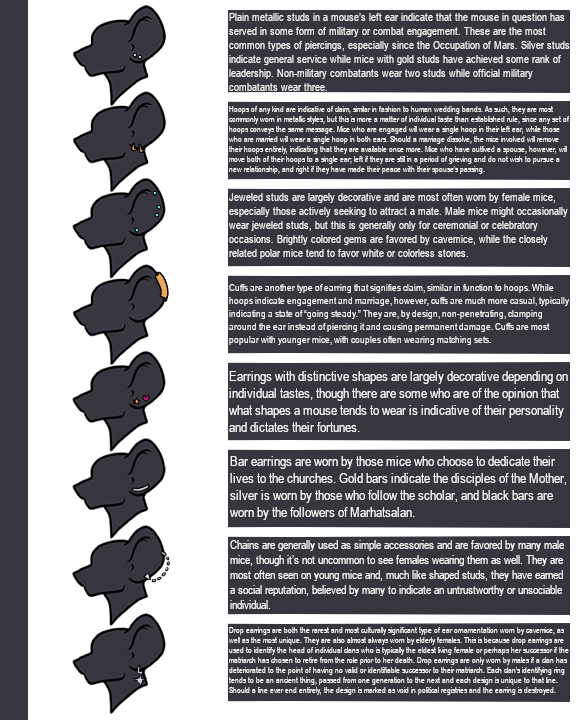
Martian Mice & the Cultural Significance of Earrings
Considering the physical prominence of their ears, the wearing of earrings has evolved into a rudimentary visual language among the cave and polar mouse population of Mars and a lot of information can be learned about any individual mouse just by the type and arrangement of their piercings. While other indigenous Martian races may wear piercings, they do not share this cultural significance.
Metallic Studs (Left Lobe): Plain metallic studs in a mouse’s left ear indicate that the mouse in question has served in some form of military or combat engagement. These are the most common types of piercings, especially since the Occupation of Mars. Silver studs indicate general service while mice with gold studs have achieved some rank of leadership. Non-military combatants wear two studs while official military combatants wear three.
Hoops (Left, Right or Both Lobes): Hoops of any kind are indicative of claim, similar in fashion to human wedding bands. As such, they are most commonly worn in metallic styles, but this is more a matter of individual taste than established rule, since any set of hoops conveys the same message. Mice who are engaged will wear a single hoop in their left ear, while those who are married will wear a single hoop in both ears. Should a marriage dissolve, the mice involved will remove their hoops entirely, indicating that they are available once more. Mice who have outlived a spouse, however, will move both of their hoops to a single ear; left if they are still in a period of grieving and do not wish to pursue a new relationship, and right if they have made their peace with their spouse’s passing.
Jeweled Studs (Either Ear, Any Location): Jeweled studs are largely decorative and are most often worn by female mice, especially those actively seeking to attract a mate. Male mice might occasionally wear jeweled studs, but this is generally only for ceremonial or celebratory occasions. Brightly colored gems are favored by cavemice, while the closely related polar mice tend to favor white or colorless stones.
Cuffs (Either Ear, Outer Shell): Cuffs are another type of earring that signifies claim, similar in function to hoops. While hoops indicate engagement and marriage, however, cuffs are much more casual, typically indicating a state of “going steady.” They are, by design, non-penetrating, clamping around the ear instead of piercing it and causing permanent damage. Cuffs are most popular with younger mice, with couples often wearing matching sets.
Shaped Studs (Either Ear, Any Location): Earrings with distinctive shapes are largely decorative depending on individual tastes, though there are some who are of the opinion that what shapes a mouse tends to wear is indicative of their personality and dictates their fortunes.
Bars (Either Lobe): Bar earrings are worn by those mice who choose to dedicate their lives to the churches. Gold bars indicate the disciples of the Mother, silver is worn by those who follow the Scholar, and black bars are worn by the followers of Marhatsalan.
Chains (Either Ear, Any Location): Chains are generally used as simple accessories and are favored by many male mice, though it’s not uncommon to see females wearing them as well. They are most often seen on young mice and, much like shaped studs, they have earned a social reputation, believed by many to indicate an untrustworthy or unsociable individual.
Drop (Either Lobe): Drop earrings are both the rarest and most culturally significant type of ear ornamentation worn by cavemice, as well as the most unique. They are also almost always worn by elderly females. This is because drop earrings are used to identify the head of individual clans who is typically the eldest living female or perhaps her successor if the matriarch has chosen to retire from the role prior to her death. Drop earrings are only worn by males if a clan has deteriorated to the point of having no valid or identifiable successor to their matriarch. Each clan’s identifying ring tends to be an ancient thing, passed from one generation to the next and each design is unique to that line. Should a line ever end entirely, the design is marked as void in political registries and the earring is destroyed.
Metallic Studs (Left Lobe): Plain metallic studs in a mouse’s left ear indicate that the mouse in question has served in some form of military or combat engagement. These are the most common types of piercings, especially since the Occupation of Mars. Silver studs indicate general service while mice with gold studs have achieved some rank of leadership. Non-military combatants wear two studs while official military combatants wear three.
Hoops (Left, Right or Both Lobes): Hoops of any kind are indicative of claim, similar in fashion to human wedding bands. As such, they are most commonly worn in metallic styles, but this is more a matter of individual taste than established rule, since any set of hoops conveys the same message. Mice who are engaged will wear a single hoop in their left ear, while those who are married will wear a single hoop in both ears. Should a marriage dissolve, the mice involved will remove their hoops entirely, indicating that they are available once more. Mice who have outlived a spouse, however, will move both of their hoops to a single ear; left if they are still in a period of grieving and do not wish to pursue a new relationship, and right if they have made their peace with their spouse’s passing.
Jeweled Studs (Either Ear, Any Location): Jeweled studs are largely decorative and are most often worn by female mice, especially those actively seeking to attract a mate. Male mice might occasionally wear jeweled studs, but this is generally only for ceremonial or celebratory occasions. Brightly colored gems are favored by cavemice, while the closely related polar mice tend to favor white or colorless stones.
Cuffs (Either Ear, Outer Shell): Cuffs are another type of earring that signifies claim, similar in function to hoops. While hoops indicate engagement and marriage, however, cuffs are much more casual, typically indicating a state of “going steady.” They are, by design, non-penetrating, clamping around the ear instead of piercing it and causing permanent damage. Cuffs are most popular with younger mice, with couples often wearing matching sets.
Shaped Studs (Either Ear, Any Location): Earrings with distinctive shapes are largely decorative depending on individual tastes, though there are some who are of the opinion that what shapes a mouse tends to wear is indicative of their personality and dictates their fortunes.
Bars (Either Lobe): Bar earrings are worn by those mice who choose to dedicate their lives to the churches. Gold bars indicate the disciples of the Mother, silver is worn by those who follow the Scholar, and black bars are worn by the followers of Marhatsalan.
Chains (Either Ear, Any Location): Chains are generally used as simple accessories and are favored by many male mice, though it’s not uncommon to see females wearing them as well. They are most often seen on young mice and, much like shaped studs, they have earned a social reputation, believed by many to indicate an untrustworthy or unsociable individual.
Drop (Either Lobe): Drop earrings are both the rarest and most culturally significant type of ear ornamentation worn by cavemice, as well as the most unique. They are also almost always worn by elderly females. This is because drop earrings are used to identify the head of individual clans who is typically the eldest living female or perhaps her successor if the matriarch has chosen to retire from the role prior to her death. Drop earrings are only worn by males if a clan has deteriorated to the point of having no valid or identifiable successor to their matriarch. Each clan’s identifying ring tends to be an ancient thing, passed from one generation to the next and each design is unique to that line. Should a line ever end entirely, the design is marked as void in political registries and the earring is destroyed.
Category All / All
Species Mouse
Gender Any
Size 576 x 720px
File Size 155.5 kB

 FA+
FA+








Comments